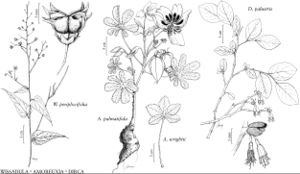Herbs [shrubs, trees], perennial, suffrutescent. Leaves alternate, stipulate, petiolate, simple, hypogynous, distinct; anthers 2-celled, straight, dehiscing via apical pores; pistil 1; ovary superior, 1–3-locular, carpels 3[–5], connate; placentation axile [parietal]; ovules 18–100+; style simple. Fruits capsular, 3[–5]-valved. Seeds 18–100+, reniform or globose to ovoid [cochleate], glabrous or hairy; endosperm oily; embryo same shape as seed.
Distribution
sw, sc United States, Mexico, West Indies, Central America, South America, Asia, Africa, Australia.
Discussion
Genera 2, species 16 (1 genus, 3 species in the flora).
Cochlospermaceae was established as a family, encompassing Cochlospermum and Amoreuxia, by J. É. Planchon (1847). It was included in the Parietales by H. G. A. Engler and K. Prantl (1887–1915) and by R. K. F. Pilger (1925). A. Cronquist (1981) placed Cochlospermum and Amoreuxia in Bixaceae in the Violales, suggesting a close relationship to Flacourtiaceae and Cistaceae. A. L. Takhtajan (1987, 1997) at first placed Cochlospermaceae in the Bixales, then later transferred it to the Cistales. The more recent placement within Malvales is supported by both morphological and molecular evidence (G. Dahlgren 1989b; W. S. Judd and S. R. Manchester 1997; P. F. Stevens, www.mobot.org/MOBOT/research/APweb/; S. D. Smith and D. A. Baum, tolweb.org/Malvales/21050/2003.03.20). There has been some discussion about the inclusion of Cochlospermum and Amoreuxia in Bixaceae. Takhtajan (1980) and Cronquist placed the two genera, along with Bixa, in Bixaceae; others, such as V. H. Heywood (1978) and H. H. Poppendieck (1980, 1981, 2003, 2003b) placed Cochlospermum and Amoreuxia in Cochlospermaceae. This segregation of Cochlospermum and Amoreuxia from Bixa has been done chiefly on the basis of their palmately lobed or compound versus simple, entire leaves, 3–5-valved versus 2-valved fruit, and oily versus starchy endosperm (Heywood). Molecular and morphological studies support the distinction of Cochlospermaceae (M. F. Fay et al. 1998; S. B. Johnson-Fulton 2014; R. C. Keating 1970, 1972; H. H. Poppendieck 1980; V. Savolainen et al. 2000b).
A thorough monograph of Cochlospermaceae was conducted by H. H. Poppendieck (1980) and the morphology and anatomy of Cochlospermaceae have been well studied by R. C. Keating (1968, 1970, 1972). Large tropical bees have been observed pollinating many Central and South American Cochlospermum species and flying foxes have been observed pollinating C. religiosum in India (P. Erancheri et al. 2013; D. W. Roubik et al. 1982; A. A. Snow and Roubik 1987). More studies on the reproductive biology are definitely needed.
Many species of Cochlospermaceae are ethnobotanically important. The starchy, tuberous roots as well as other parts of Amoreuxia species have been used for food by indigenous tribes in Mexico and southwestern United States (W. C. Hodgson 2001; D. Yetman and T. R. Van Devender 2002). The bark fiber of Cochlospermum has been used traditionally throughout its range to make cordage. The seed hairs of many species of Cochlospermum have been used as filling for pillows in South America. Some of the documented medicinal uses for certain species of Cochlospermum include treatments for jaundice, stomach problems, leprosy, and asthma (D. K. Abbiw 1990; J. F. Morton 1981; H. H. Poppendieck 1980; P. K. Warrier et al. 1993+, vol. 2). Certain species of Cochlospermum are grown as ornamentals in tropical and subtropical gardens throughout the world (N. P. Smith et al. 2004). Cochlospermum religiosum, and C. vitifolium are cultivated in the United States; none has escaped.
